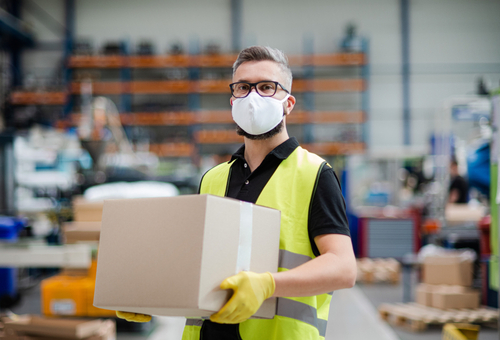Over recent months business and organisations the world over have had to take an ‘adapt or die’ approach to their operations in order to survive. With differing guidelines the world over that looked different from country to country.
One guideline that has been implemented in most countries is that of social distancing. The distance and rules may vary but the general consensus is that keeping our distance is a preventative measure against COVID-19.
Warehouses are known for being extremely busy, bustling places to work and there can be hundreds of people in and out of the building on any given day – whether that is managing inbound and outbound, packing, picking, ecommerce fulfilment or returns services. Therefore meticulous measures must be put in place to keep staff and visitors safe. So how can we continue to have an efficient and fully operational warehouse whilst adhering to social distancing guidelines?
Implementing Social Distancing in Warehousing
Warehouse space is being reassessed by those who use it, being that it comes at a cost it is important to consistently review how the space is being used safely and efficiently.
Here are a few ways that can be done:
- Implementing one way systems via marked walkways and directional arrows on flooring.
- Organising shift patterns of workers to optimise skill sets at certain times and reduce the number of people on site at any one time as, and limit or eradicate face to face interaction.
- Sanitation of equipment being used such as electronic terminals, forklifts, trolleys, workstations etc cleaning between shifts.
- Keeping differing work processes separate, therefore segregating activities and teams into bubbles.
- Reduce the amount of staff onsite where it is not possible to adhere to current social distancing guidelines.
- Constantly review processes as guidelines change, moving with Government advice and always whilst keeping people’s safety a priority.
- Make Social Distancing part of forward planning for upcoming peak periods such as Black Friday and Christmas.
- Review space, does it make sense to extend by the use of prefab buildings for breaktime rest areas? Are there ways to regain lost space?
- Consider staggered start and finish times to shifts to reduce footfall, creating bubbles or small teams will help to reduce the risk of infection between workers.
- Consider the implications that social distancing has on costs as processes are likely to take longer and productivity is down temporarily.
Only through real understanding of the supply chain can we adjust operation sensibly and safely without having too much of a costly impact. Social distancing is likely to be the longest standing piece of Government guidance, and therefore a critical issue to address in order to move into the new normal for the logistics sector and beyond.





